Strategies for Employee Retention and Attraction in Agriculture
VerifiedAdded on 2023/06/04
|11
|3191
|198
Essay
AI Summary
This essay delves into the significant challenges of attracting and retaining employees within the Australian agriculture sector, an industry often perceived as less skilled and labor-competitive. It highlights the difficulties in managing human capital due to the prevalence of part-time employment and the informal nature of agricultural work, which hinders the attraction of skilled labor. The essay discusses how the sector's public image, aggressive competition from other industries, limited career development opportunities, and high employee turnover further exacerbate these challenges. Drawing upon theories such as human capital theory, Herzberg's two-factor theory, and attraction-retention theory, the analysis emphasizes the need for strategic interventions to improve working conditions, enhance career planning, and address negative public perceptions to foster a more attractive and sustainable agricultural workforce. The essay concludes by underscoring the importance of human resource planning and competitive compensation to mitigate turnover and ensure the sector's long-term growth and stability.
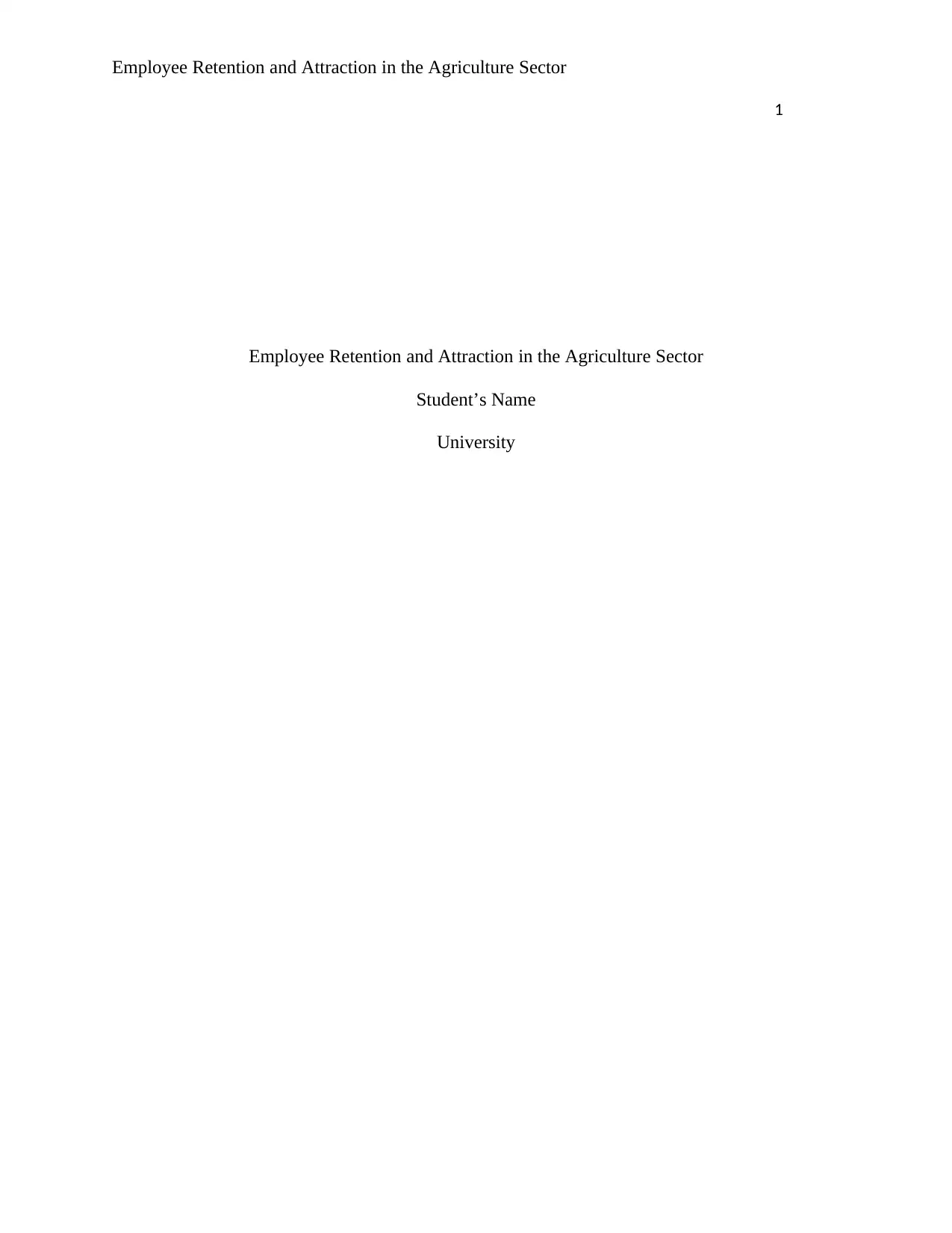
Employee Retention and Attraction in the Agriculture Sector
1
Employee Retention and Attraction in the Agriculture Sector
Student’s Name
University
1
Employee Retention and Attraction in the Agriculture Sector
Student’s Name
University
Paraphrase This Document
Need a fresh take? Get an instant paraphrase of this document with our AI Paraphraser
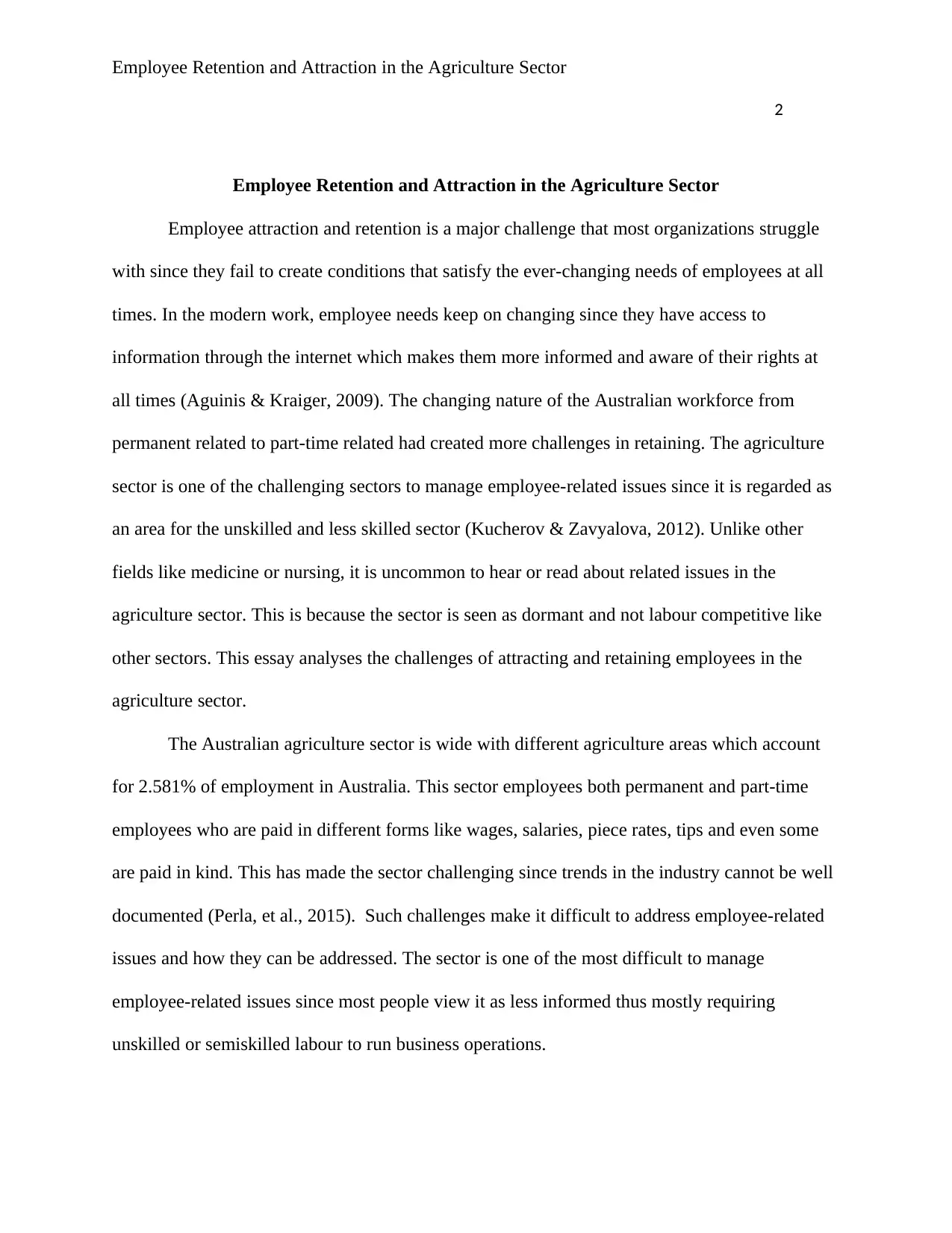
Employee Retention and Attraction in the Agriculture Sector
2
Employee Retention and Attraction in the Agriculture Sector
Employee attraction and retention is a major challenge that most organizations struggle
with since they fail to create conditions that satisfy the ever-changing needs of employees at all
times. In the modern work, employee needs keep on changing since they have access to
information through the internet which makes them more informed and aware of their rights at
all times (Aguinis & Kraiger, 2009). The changing nature of the Australian workforce from
permanent related to part-time related had created more challenges in retaining. The agriculture
sector is one of the challenging sectors to manage employee-related issues since it is regarded as
an area for the unskilled and less skilled sector (Kucherov & Zavyalova, 2012). Unlike other
fields like medicine or nursing, it is uncommon to hear or read about related issues in the
agriculture sector. This is because the sector is seen as dormant and not labour competitive like
other sectors. This essay analyses the challenges of attracting and retaining employees in the
agriculture sector.
The Australian agriculture sector is wide with different agriculture areas which account
for 2.581% of employment in Australia. This sector employees both permanent and part-time
employees who are paid in different forms like wages, salaries, piece rates, tips and even some
are paid in kind. This has made the sector challenging since trends in the industry cannot be well
documented (Perla, et al., 2015). Such challenges make it difficult to address employee-related
issues and how they can be addressed. The sector is one of the most difficult to manage
employee-related issues since most people view it as less informed thus mostly requiring
unskilled or semiskilled labour to run business operations.
2
Employee Retention and Attraction in the Agriculture Sector
Employee attraction and retention is a major challenge that most organizations struggle
with since they fail to create conditions that satisfy the ever-changing needs of employees at all
times. In the modern work, employee needs keep on changing since they have access to
information through the internet which makes them more informed and aware of their rights at
all times (Aguinis & Kraiger, 2009). The changing nature of the Australian workforce from
permanent related to part-time related had created more challenges in retaining. The agriculture
sector is one of the challenging sectors to manage employee-related issues since it is regarded as
an area for the unskilled and less skilled sector (Kucherov & Zavyalova, 2012). Unlike other
fields like medicine or nursing, it is uncommon to hear or read about related issues in the
agriculture sector. This is because the sector is seen as dormant and not labour competitive like
other sectors. This essay analyses the challenges of attracting and retaining employees in the
agriculture sector.
The Australian agriculture sector is wide with different agriculture areas which account
for 2.581% of employment in Australia. This sector employees both permanent and part-time
employees who are paid in different forms like wages, salaries, piece rates, tips and even some
are paid in kind. This has made the sector challenging since trends in the industry cannot be well
documented (Perla, et al., 2015). Such challenges make it difficult to address employee-related
issues and how they can be addressed. The sector is one of the most difficult to manage
employee-related issues since most people view it as less informed thus mostly requiring
unskilled or semiskilled labour to run business operations.
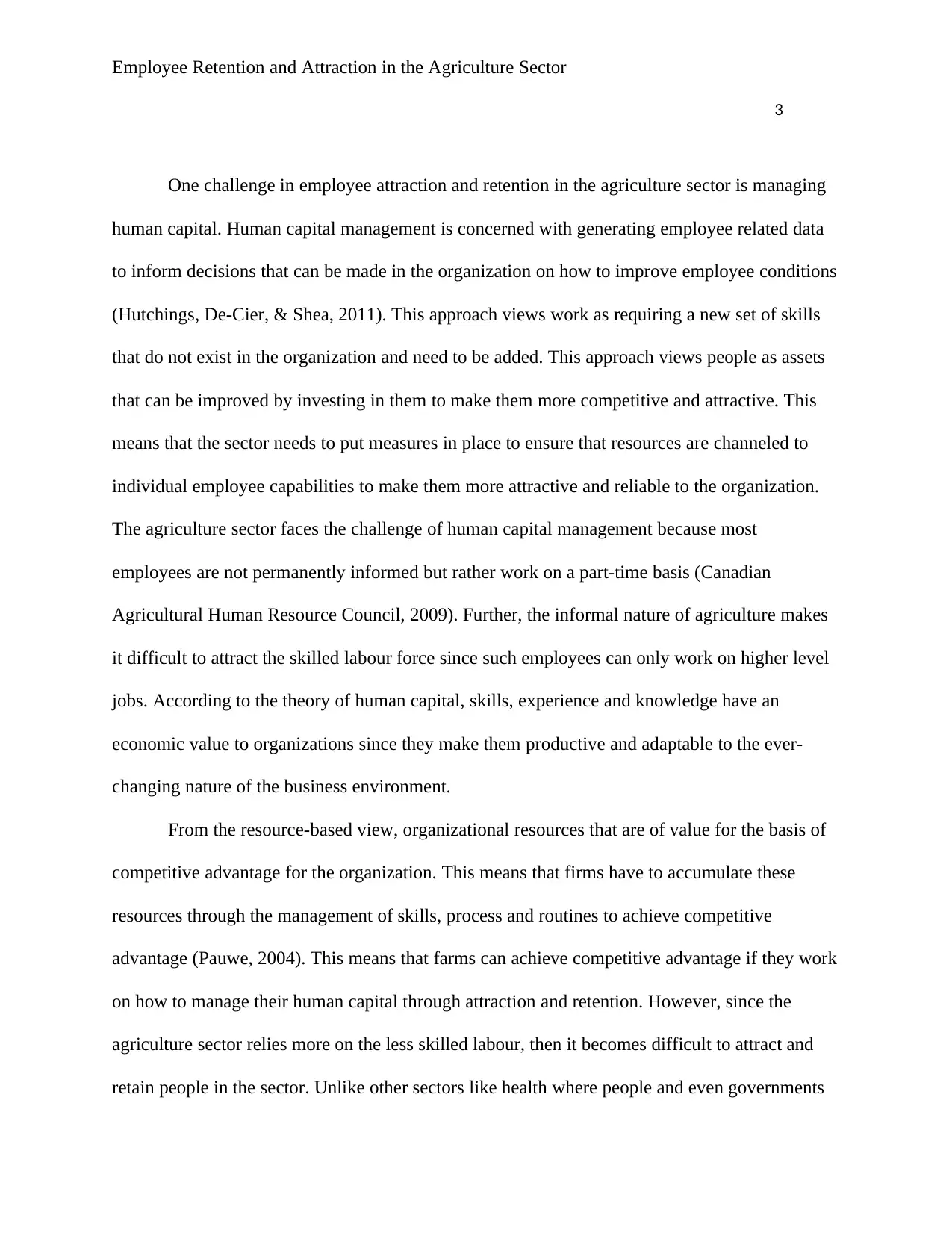
Employee Retention and Attraction in the Agriculture Sector
3
One challenge in employee attraction and retention in the agriculture sector is managing
human capital. Human capital management is concerned with generating employee related data
to inform decisions that can be made in the organization on how to improve employee conditions
(Hutchings, De-Cier, & Shea, 2011). This approach views work as requiring a new set of skills
that do not exist in the organization and need to be added. This approach views people as assets
that can be improved by investing in them to make them more competitive and attractive. This
means that the sector needs to put measures in place to ensure that resources are channeled to
individual employee capabilities to make them more attractive and reliable to the organization.
The agriculture sector faces the challenge of human capital management because most
employees are not permanently informed but rather work on a part-time basis (Canadian
Agricultural Human Resource Council, 2009). Further, the informal nature of agriculture makes
it difficult to attract the skilled labour force since such employees can only work on higher level
jobs. According to the theory of human capital, skills, experience and knowledge have an
economic value to organizations since they make them productive and adaptable to the ever-
changing nature of the business environment.
From the resource-based view, organizational resources that are of value for the basis of
competitive advantage for the organization. This means that firms have to accumulate these
resources through the management of skills, process and routines to achieve competitive
advantage (Pauwe, 2004). This means that farms can achieve competitive advantage if they work
on how to manage their human capital through attraction and retention. However, since the
agriculture sector relies more on the less skilled labour, then it becomes difficult to attract and
retain people in the sector. Unlike other sectors like health where people and even governments
3
One challenge in employee attraction and retention in the agriculture sector is managing
human capital. Human capital management is concerned with generating employee related data
to inform decisions that can be made in the organization on how to improve employee conditions
(Hutchings, De-Cier, & Shea, 2011). This approach views work as requiring a new set of skills
that do not exist in the organization and need to be added. This approach views people as assets
that can be improved by investing in them to make them more competitive and attractive. This
means that the sector needs to put measures in place to ensure that resources are channeled to
individual employee capabilities to make them more attractive and reliable to the organization.
The agriculture sector faces the challenge of human capital management because most
employees are not permanently informed but rather work on a part-time basis (Canadian
Agricultural Human Resource Council, 2009). Further, the informal nature of agriculture makes
it difficult to attract the skilled labour force since such employees can only work on higher level
jobs. According to the theory of human capital, skills, experience and knowledge have an
economic value to organizations since they make them productive and adaptable to the ever-
changing nature of the business environment.
From the resource-based view, organizational resources that are of value for the basis of
competitive advantage for the organization. This means that firms have to accumulate these
resources through the management of skills, process and routines to achieve competitive
advantage (Pauwe, 2004). This means that farms can achieve competitive advantage if they work
on how to manage their human capital through attraction and retention. However, since the
agriculture sector relies more on the less skilled labour, then it becomes difficult to attract and
retain people in the sector. Unlike other sectors like health where people and even governments
⊘ This is a preview!⊘
Do you want full access?
Subscribe today to unlock all pages.

Trusted by 1+ million students worldwide
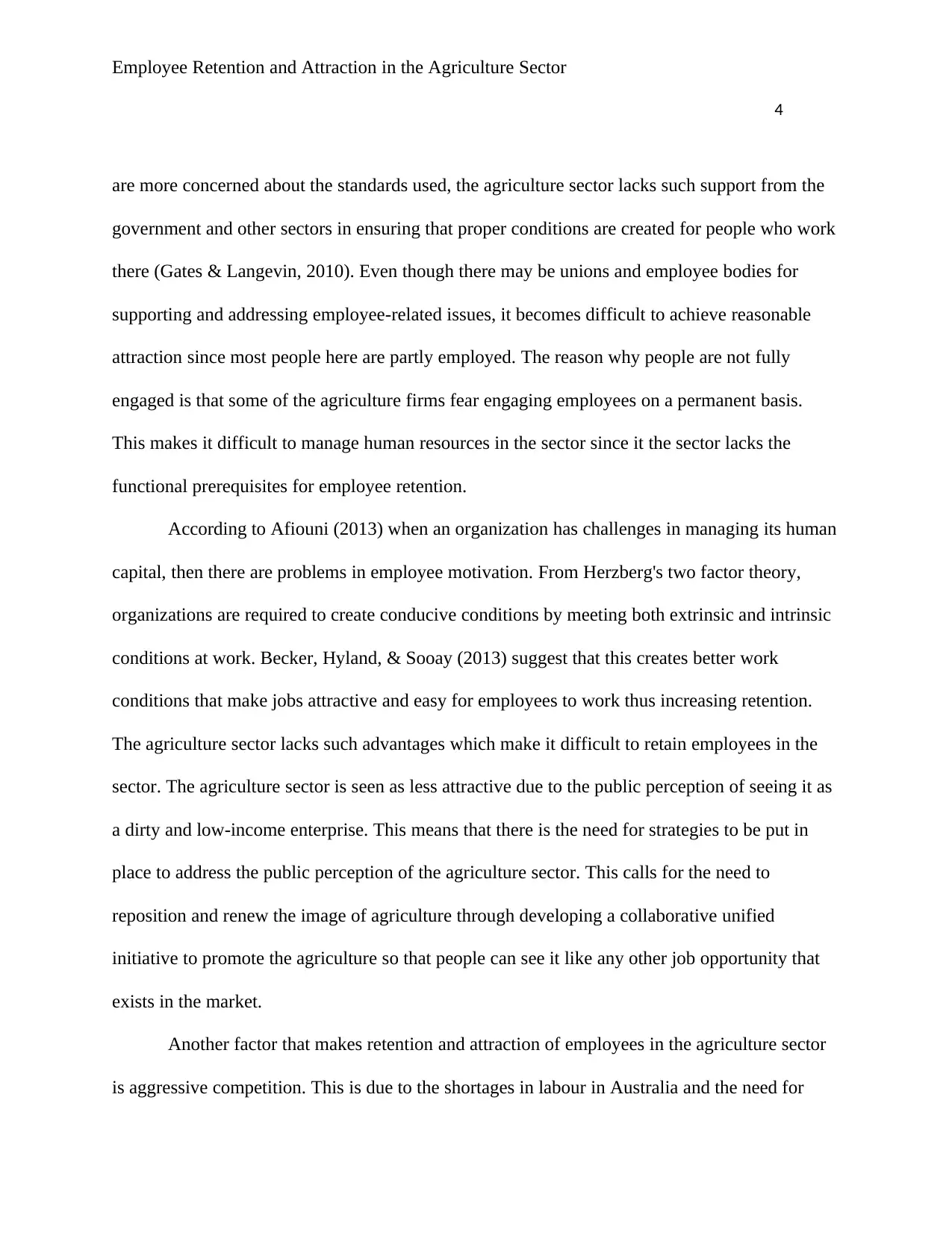
Employee Retention and Attraction in the Agriculture Sector
4
are more concerned about the standards used, the agriculture sector lacks such support from the
government and other sectors in ensuring that proper conditions are created for people who work
there (Gates & Langevin, 2010). Even though there may be unions and employee bodies for
supporting and addressing employee-related issues, it becomes difficult to achieve reasonable
attraction since most people here are partly employed. The reason why people are not fully
engaged is that some of the agriculture firms fear engaging employees on a permanent basis.
This makes it difficult to manage human resources in the sector since it the sector lacks the
functional prerequisites for employee retention.
According to Afiouni (2013) when an organization has challenges in managing its human
capital, then there are problems in employee motivation. From Herzberg's two factor theory,
organizations are required to create conducive conditions by meeting both extrinsic and intrinsic
conditions at work. Becker, Hyland, & Sooay (2013) suggest that this creates better work
conditions that make jobs attractive and easy for employees to work thus increasing retention.
The agriculture sector lacks such advantages which make it difficult to retain employees in the
sector. The agriculture sector is seen as less attractive due to the public perception of seeing it as
a dirty and low-income enterprise. This means that there is the need for strategies to be put in
place to address the public perception of the agriculture sector. This calls for the need to
reposition and renew the image of agriculture through developing a collaborative unified
initiative to promote the agriculture so that people can see it like any other job opportunity that
exists in the market.
Another factor that makes retention and attraction of employees in the agriculture sector
is aggressive competition. This is due to the shortages in labour in Australia and the need for
4
are more concerned about the standards used, the agriculture sector lacks such support from the
government and other sectors in ensuring that proper conditions are created for people who work
there (Gates & Langevin, 2010). Even though there may be unions and employee bodies for
supporting and addressing employee-related issues, it becomes difficult to achieve reasonable
attraction since most people here are partly employed. The reason why people are not fully
engaged is that some of the agriculture firms fear engaging employees on a permanent basis.
This makes it difficult to manage human resources in the sector since it the sector lacks the
functional prerequisites for employee retention.
According to Afiouni (2013) when an organization has challenges in managing its human
capital, then there are problems in employee motivation. From Herzberg's two factor theory,
organizations are required to create conducive conditions by meeting both extrinsic and intrinsic
conditions at work. Becker, Hyland, & Sooay (2013) suggest that this creates better work
conditions that make jobs attractive and easy for employees to work thus increasing retention.
The agriculture sector lacks such advantages which make it difficult to retain employees in the
sector. The agriculture sector is seen as less attractive due to the public perception of seeing it as
a dirty and low-income enterprise. This means that there is the need for strategies to be put in
place to address the public perception of the agriculture sector. This calls for the need to
reposition and renew the image of agriculture through developing a collaborative unified
initiative to promote the agriculture so that people can see it like any other job opportunity that
exists in the market.
Another factor that makes retention and attraction of employees in the agriculture sector
is aggressive competition. This is due to the shortages in labour in Australia and the need for
Paraphrase This Document
Need a fresh take? Get an instant paraphrase of this document with our AI Paraphraser
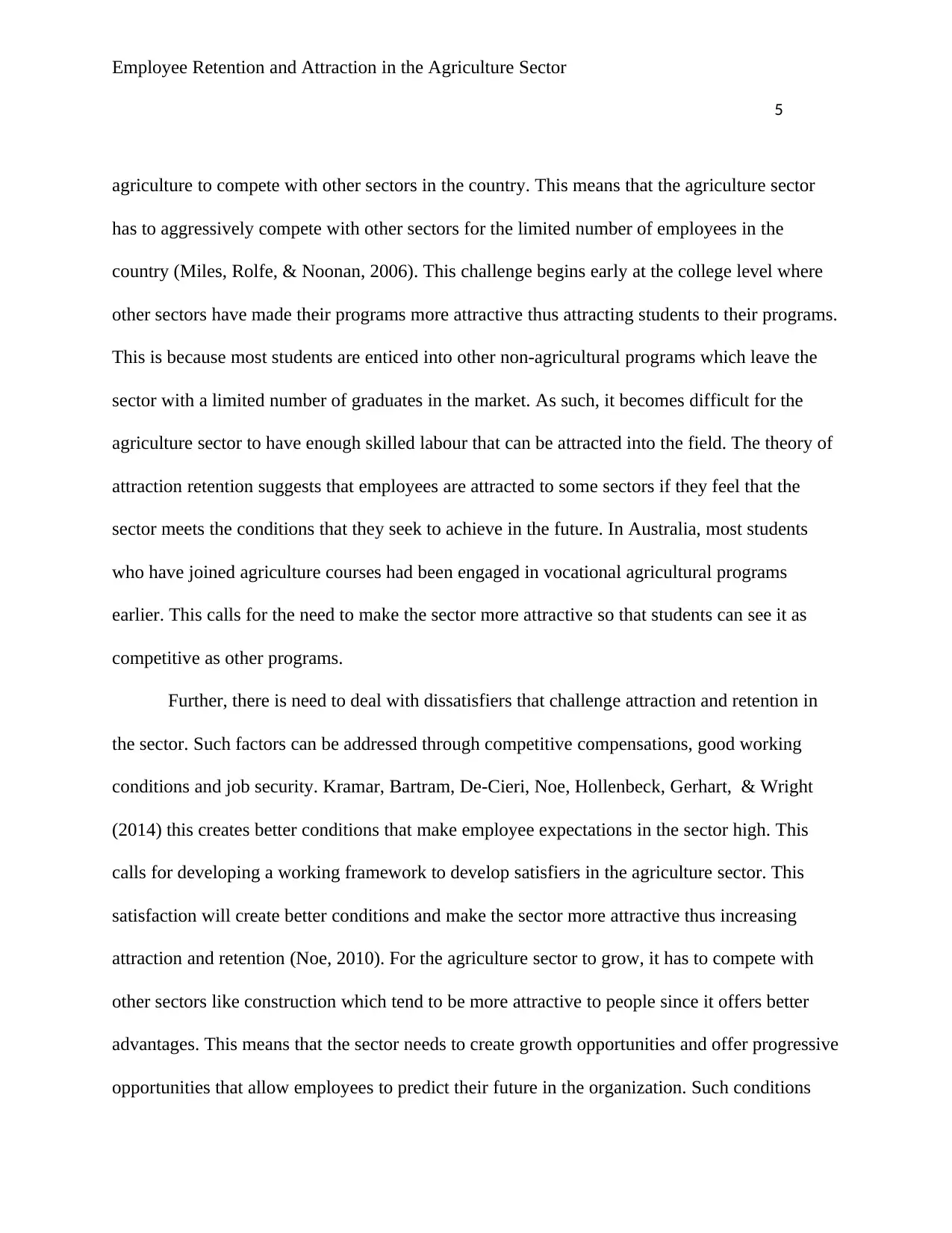
Employee Retention and Attraction in the Agriculture Sector
5
agriculture to compete with other sectors in the country. This means that the agriculture sector
has to aggressively compete with other sectors for the limited number of employees in the
country (Miles, Rolfe, & Noonan, 2006). This challenge begins early at the college level where
other sectors have made their programs more attractive thus attracting students to their programs.
This is because most students are enticed into other non-agricultural programs which leave the
sector with a limited number of graduates in the market. As such, it becomes difficult for the
agriculture sector to have enough skilled labour that can be attracted into the field. The theory of
attraction retention suggests that employees are attracted to some sectors if they feel that the
sector meets the conditions that they seek to achieve in the future. In Australia, most students
who have joined agriculture courses had been engaged in vocational agricultural programs
earlier. This calls for the need to make the sector more attractive so that students can see it as
competitive as other programs.
Further, there is need to deal with dissatisfiers that challenge attraction and retention in
the sector. Such factors can be addressed through competitive compensations, good working
conditions and job security. Kramar, Bartram, De-Cieri, Noe, Hollenbeck, Gerhart, & Wright
(2014) this creates better conditions that make employee expectations in the sector high. This
calls for developing a working framework to develop satisfiers in the agriculture sector. This
satisfaction will create better conditions and make the sector more attractive thus increasing
attraction and retention (Noe, 2010). For the agriculture sector to grow, it has to compete with
other sectors like construction which tend to be more attractive to people since it offers better
advantages. This means that the sector needs to create growth opportunities and offer progressive
opportunities that allow employees to predict their future in the organization. Such conditions
5
agriculture to compete with other sectors in the country. This means that the agriculture sector
has to aggressively compete with other sectors for the limited number of employees in the
country (Miles, Rolfe, & Noonan, 2006). This challenge begins early at the college level where
other sectors have made their programs more attractive thus attracting students to their programs.
This is because most students are enticed into other non-agricultural programs which leave the
sector with a limited number of graduates in the market. As such, it becomes difficult for the
agriculture sector to have enough skilled labour that can be attracted into the field. The theory of
attraction retention suggests that employees are attracted to some sectors if they feel that the
sector meets the conditions that they seek to achieve in the future. In Australia, most students
who have joined agriculture courses had been engaged in vocational agricultural programs
earlier. This calls for the need to make the sector more attractive so that students can see it as
competitive as other programs.
Further, there is need to deal with dissatisfiers that challenge attraction and retention in
the sector. Such factors can be addressed through competitive compensations, good working
conditions and job security. Kramar, Bartram, De-Cieri, Noe, Hollenbeck, Gerhart, & Wright
(2014) this creates better conditions that make employee expectations in the sector high. This
calls for developing a working framework to develop satisfiers in the agriculture sector. This
satisfaction will create better conditions and make the sector more attractive thus increasing
attraction and retention (Noe, 2010). For the agriculture sector to grow, it has to compete with
other sectors like construction which tend to be more attractive to people since it offers better
advantages. This means that the sector needs to create growth opportunities and offer progressive
opportunities that allow employees to predict their future in the organization. Such conditions
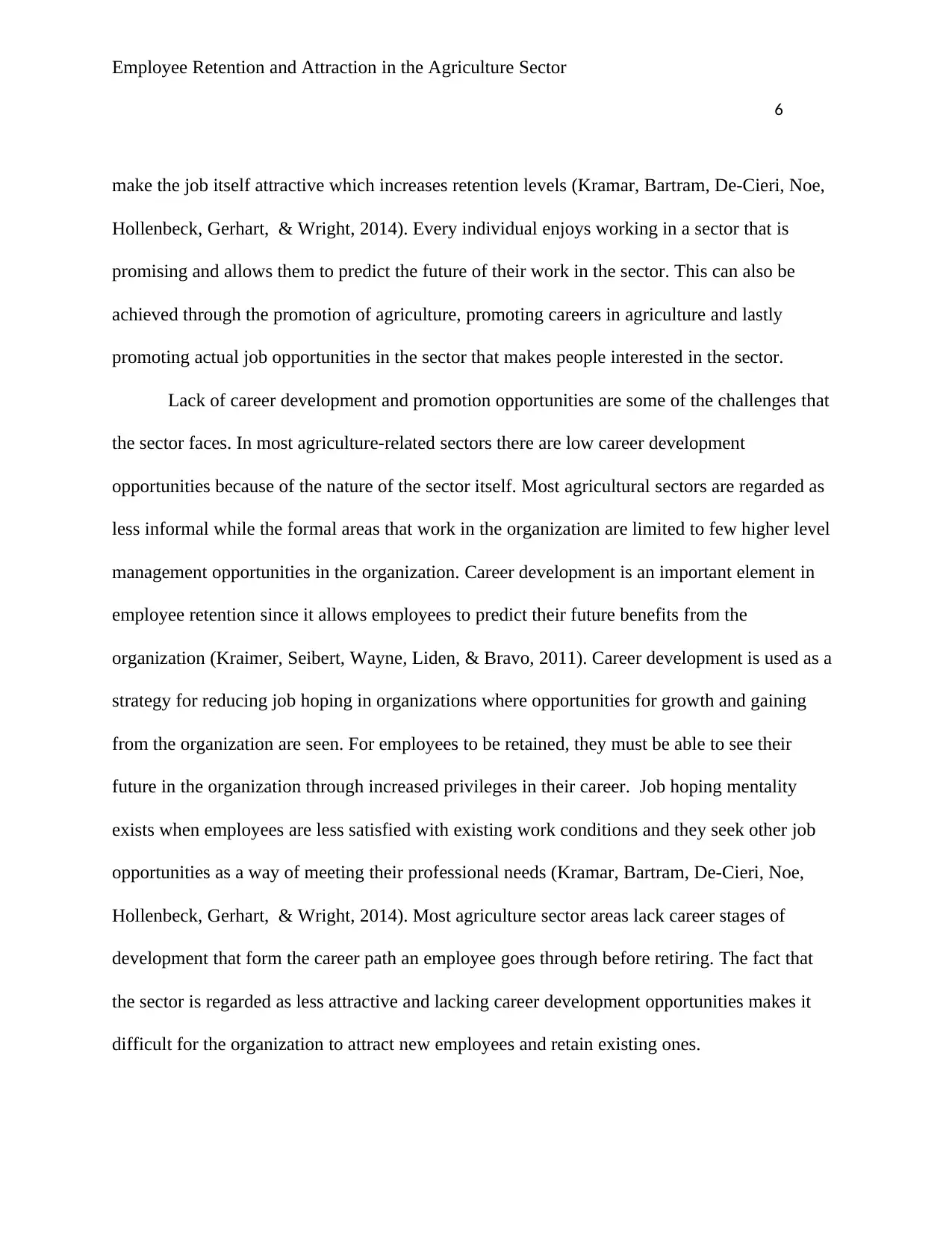
Employee Retention and Attraction in the Agriculture Sector
6
make the job itself attractive which increases retention levels (Kramar, Bartram, De-Cieri, Noe,
Hollenbeck, Gerhart, & Wright, 2014). Every individual enjoys working in a sector that is
promising and allows them to predict the future of their work in the sector. This can also be
achieved through the promotion of agriculture, promoting careers in agriculture and lastly
promoting actual job opportunities in the sector that makes people interested in the sector.
Lack of career development and promotion opportunities are some of the challenges that
the sector faces. In most agriculture-related sectors there are low career development
opportunities because of the nature of the sector itself. Most agricultural sectors are regarded as
less informal while the formal areas that work in the organization are limited to few higher level
management opportunities in the organization. Career development is an important element in
employee retention since it allows employees to predict their future benefits from the
organization (Kraimer, Seibert, Wayne, Liden, & Bravo, 2011). Career development is used as a
strategy for reducing job hoping in organizations where opportunities for growth and gaining
from the organization are seen. For employees to be retained, they must be able to see their
future in the organization through increased privileges in their career. Job hoping mentality
exists when employees are less satisfied with existing work conditions and they seek other job
opportunities as a way of meeting their professional needs (Kramar, Bartram, De-Cieri, Noe,
Hollenbeck, Gerhart, & Wright, 2014). Most agriculture sector areas lack career stages of
development that form the career path an employee goes through before retiring. The fact that
the sector is regarded as less attractive and lacking career development opportunities makes it
difficult for the organization to attract new employees and retain existing ones.
6
make the job itself attractive which increases retention levels (Kramar, Bartram, De-Cieri, Noe,
Hollenbeck, Gerhart, & Wright, 2014). Every individual enjoys working in a sector that is
promising and allows them to predict the future of their work in the sector. This can also be
achieved through the promotion of agriculture, promoting careers in agriculture and lastly
promoting actual job opportunities in the sector that makes people interested in the sector.
Lack of career development and promotion opportunities are some of the challenges that
the sector faces. In most agriculture-related sectors there are low career development
opportunities because of the nature of the sector itself. Most agricultural sectors are regarded as
less informal while the formal areas that work in the organization are limited to few higher level
management opportunities in the organization. Career development is an important element in
employee retention since it allows employees to predict their future benefits from the
organization (Kraimer, Seibert, Wayne, Liden, & Bravo, 2011). Career development is used as a
strategy for reducing job hoping in organizations where opportunities for growth and gaining
from the organization are seen. For employees to be retained, they must be able to see their
future in the organization through increased privileges in their career. Job hoping mentality
exists when employees are less satisfied with existing work conditions and they seek other job
opportunities as a way of meeting their professional needs (Kramar, Bartram, De-Cieri, Noe,
Hollenbeck, Gerhart, & Wright, 2014). Most agriculture sector areas lack career stages of
development that form the career path an employee goes through before retiring. The fact that
the sector is regarded as less attractive and lacking career development opportunities makes it
difficult for the organization to attract new employees and retain existing ones.
⊘ This is a preview!⊘
Do you want full access?
Subscribe today to unlock all pages.

Trusted by 1+ million students worldwide
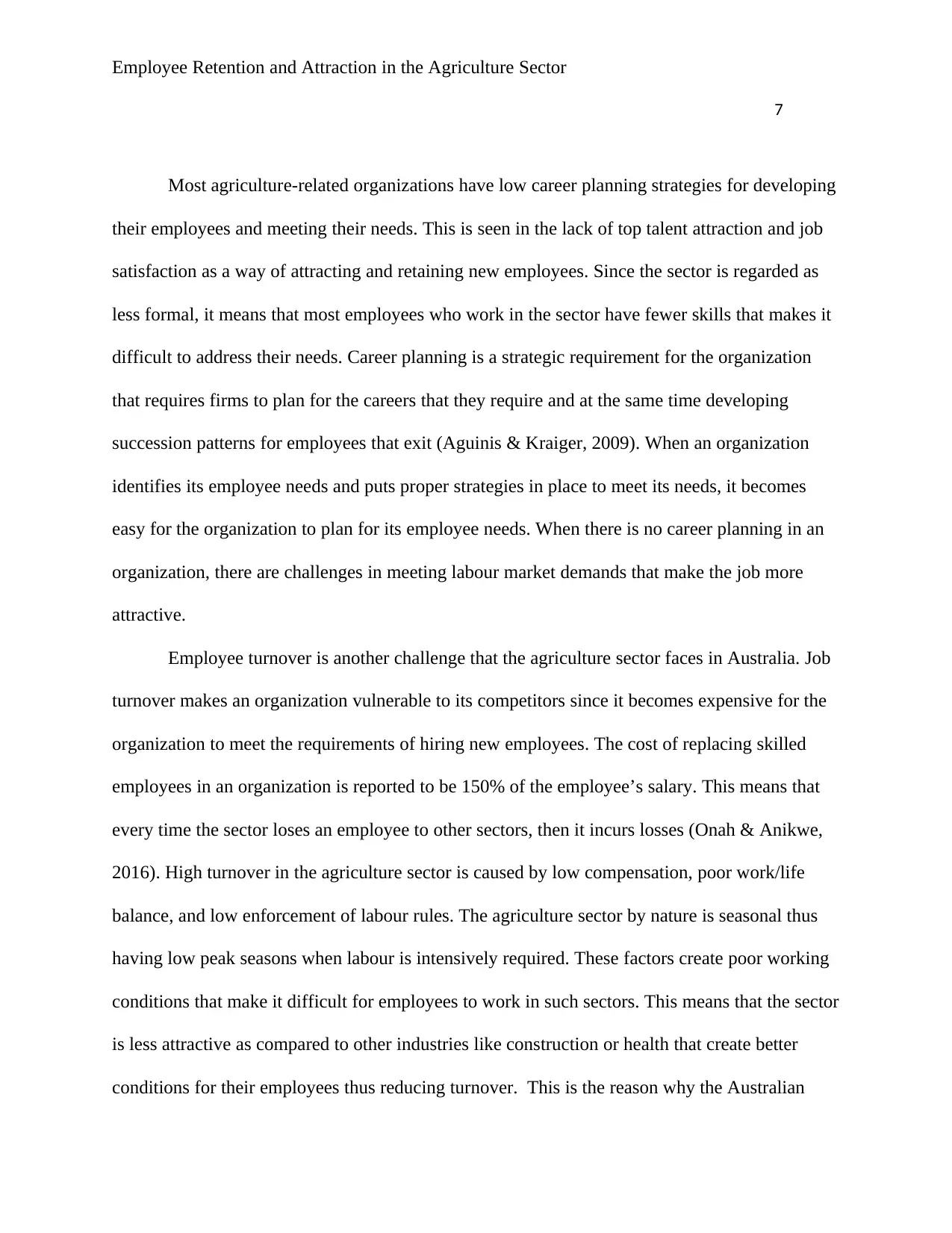
Employee Retention and Attraction in the Agriculture Sector
7
Most agriculture-related organizations have low career planning strategies for developing
their employees and meeting their needs. This is seen in the lack of top talent attraction and job
satisfaction as a way of attracting and retaining new employees. Since the sector is regarded as
less formal, it means that most employees who work in the sector have fewer skills that makes it
difficult to address their needs. Career planning is a strategic requirement for the organization
that requires firms to plan for the careers that they require and at the same time developing
succession patterns for employees that exit (Aguinis & Kraiger, 2009). When an organization
identifies its employee needs and puts proper strategies in place to meet its needs, it becomes
easy for the organization to plan for its employee needs. When there is no career planning in an
organization, there are challenges in meeting labour market demands that make the job more
attractive.
Employee turnover is another challenge that the agriculture sector faces in Australia. Job
turnover makes an organization vulnerable to its competitors since it becomes expensive for the
organization to meet the requirements of hiring new employees. The cost of replacing skilled
employees in an organization is reported to be 150% of the employee’s salary. This means that
every time the sector loses an employee to other sectors, then it incurs losses (Onah & Anikwe,
2016). High turnover in the agriculture sector is caused by low compensation, poor work/life
balance, and low enforcement of labour rules. The agriculture sector by nature is seasonal thus
having low peak seasons when labour is intensively required. These factors create poor working
conditions that make it difficult for employees to work in such sectors. This means that the sector
is less attractive as compared to other industries like construction or health that create better
conditions for their employees thus reducing turnover. This is the reason why the Australian
7
Most agriculture-related organizations have low career planning strategies for developing
their employees and meeting their needs. This is seen in the lack of top talent attraction and job
satisfaction as a way of attracting and retaining new employees. Since the sector is regarded as
less formal, it means that most employees who work in the sector have fewer skills that makes it
difficult to address their needs. Career planning is a strategic requirement for the organization
that requires firms to plan for the careers that they require and at the same time developing
succession patterns for employees that exit (Aguinis & Kraiger, 2009). When an organization
identifies its employee needs and puts proper strategies in place to meet its needs, it becomes
easy for the organization to plan for its employee needs. When there is no career planning in an
organization, there are challenges in meeting labour market demands that make the job more
attractive.
Employee turnover is another challenge that the agriculture sector faces in Australia. Job
turnover makes an organization vulnerable to its competitors since it becomes expensive for the
organization to meet the requirements of hiring new employees. The cost of replacing skilled
employees in an organization is reported to be 150% of the employee’s salary. This means that
every time the sector loses an employee to other sectors, then it incurs losses (Onah & Anikwe,
2016). High turnover in the agriculture sector is caused by low compensation, poor work/life
balance, and low enforcement of labour rules. The agriculture sector by nature is seasonal thus
having low peak seasons when labour is intensively required. These factors create poor working
conditions that make it difficult for employees to work in such sectors. This means that the sector
is less attractive as compared to other industries like construction or health that create better
conditions for their employees thus reducing turnover. This is the reason why the Australian
Paraphrase This Document
Need a fresh take? Get an instant paraphrase of this document with our AI Paraphraser
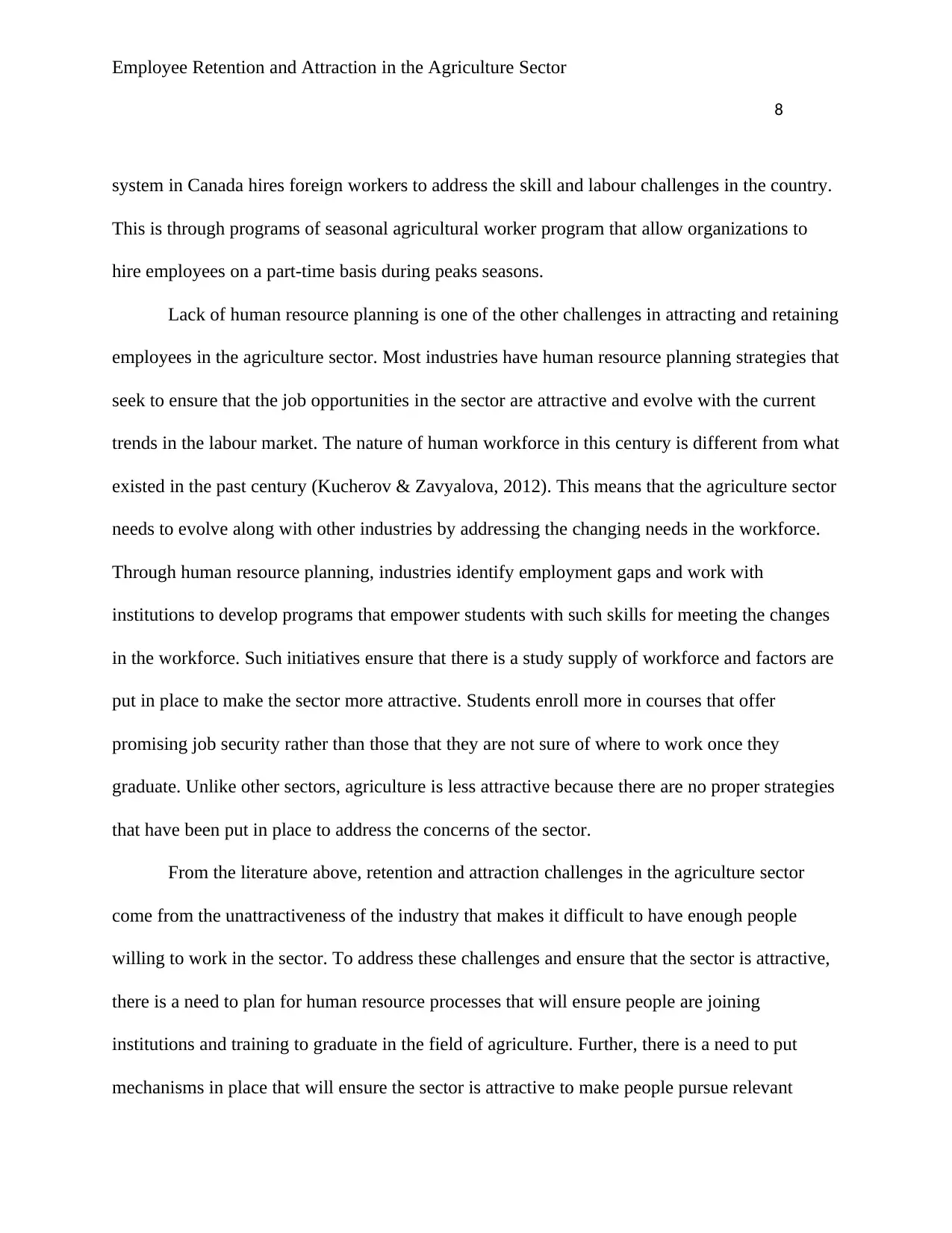
Employee Retention and Attraction in the Agriculture Sector
8
system in Canada hires foreign workers to address the skill and labour challenges in the country.
This is through programs of seasonal agricultural worker program that allow organizations to
hire employees on a part-time basis during peaks seasons.
Lack of human resource planning is one of the other challenges in attracting and retaining
employees in the agriculture sector. Most industries have human resource planning strategies that
seek to ensure that the job opportunities in the sector are attractive and evolve with the current
trends in the labour market. The nature of human workforce in this century is different from what
existed in the past century (Kucherov & Zavyalova, 2012). This means that the agriculture sector
needs to evolve along with other industries by addressing the changing needs in the workforce.
Through human resource planning, industries identify employment gaps and work with
institutions to develop programs that empower students with such skills for meeting the changes
in the workforce. Such initiatives ensure that there is a study supply of workforce and factors are
put in place to make the sector more attractive. Students enroll more in courses that offer
promising job security rather than those that they are not sure of where to work once they
graduate. Unlike other sectors, agriculture is less attractive because there are no proper strategies
that have been put in place to address the concerns of the sector.
From the literature above, retention and attraction challenges in the agriculture sector
come from the unattractiveness of the industry that makes it difficult to have enough people
willing to work in the sector. To address these challenges and ensure that the sector is attractive,
there is a need to plan for human resource processes that will ensure people are joining
institutions and training to graduate in the field of agriculture. Further, there is a need to put
mechanisms in place that will ensure the sector is attractive to make people pursue relevant
8
system in Canada hires foreign workers to address the skill and labour challenges in the country.
This is through programs of seasonal agricultural worker program that allow organizations to
hire employees on a part-time basis during peaks seasons.
Lack of human resource planning is one of the other challenges in attracting and retaining
employees in the agriculture sector. Most industries have human resource planning strategies that
seek to ensure that the job opportunities in the sector are attractive and evolve with the current
trends in the labour market. The nature of human workforce in this century is different from what
existed in the past century (Kucherov & Zavyalova, 2012). This means that the agriculture sector
needs to evolve along with other industries by addressing the changing needs in the workforce.
Through human resource planning, industries identify employment gaps and work with
institutions to develop programs that empower students with such skills for meeting the changes
in the workforce. Such initiatives ensure that there is a study supply of workforce and factors are
put in place to make the sector more attractive. Students enroll more in courses that offer
promising job security rather than those that they are not sure of where to work once they
graduate. Unlike other sectors, agriculture is less attractive because there are no proper strategies
that have been put in place to address the concerns of the sector.
From the literature above, retention and attraction challenges in the agriculture sector
come from the unattractiveness of the industry that makes it difficult to have enough people
willing to work in the sector. To address these challenges and ensure that the sector is attractive,
there is a need to plan for human resource processes that will ensure people are joining
institutions and training to graduate in the field of agriculture. Further, there is a need to put
mechanisms in place that will ensure the sector is attractive to make people pursue relevant
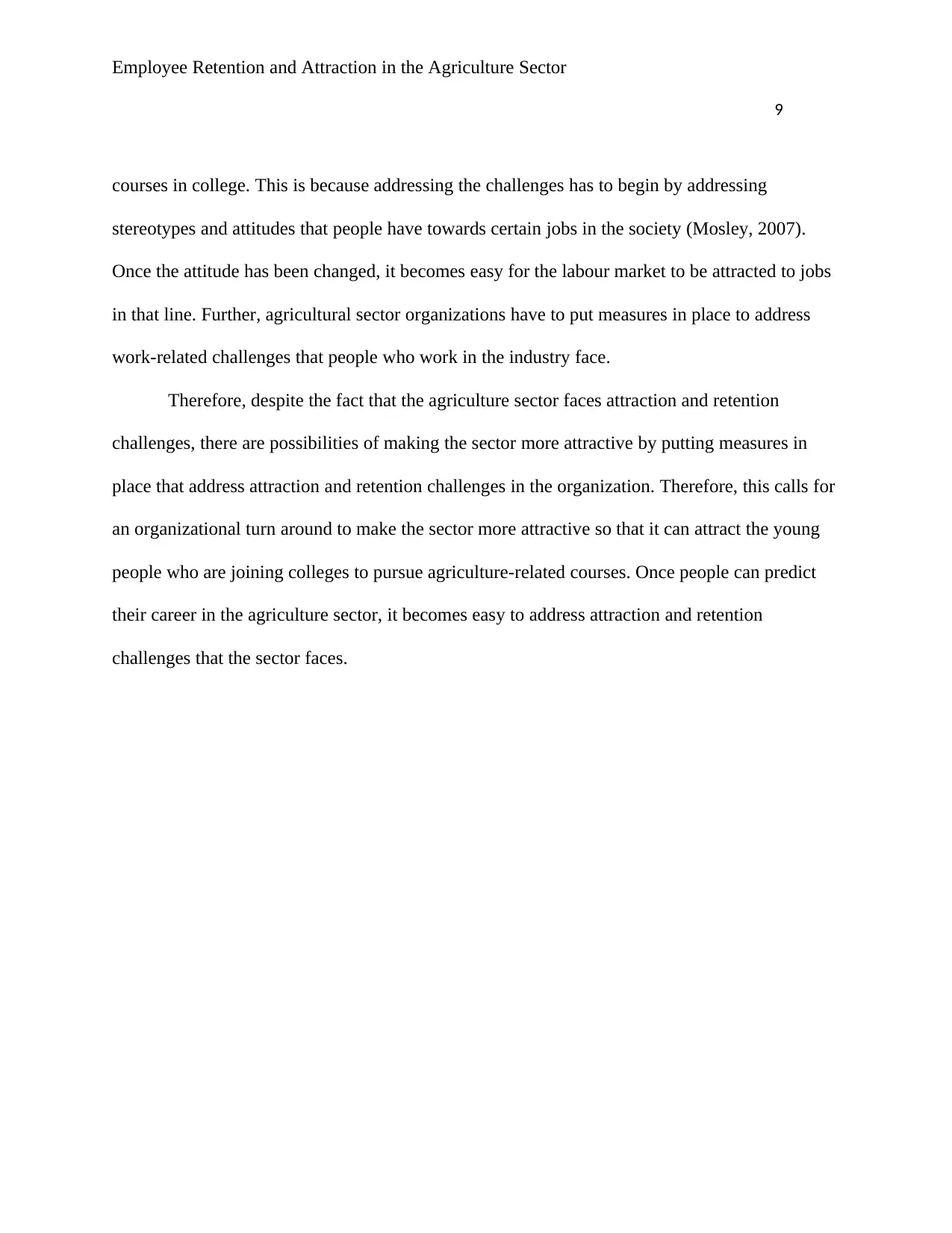
Employee Retention and Attraction in the Agriculture Sector
9
courses in college. This is because addressing the challenges has to begin by addressing
stereotypes and attitudes that people have towards certain jobs in the society (Mosley, 2007).
Once the attitude has been changed, it becomes easy for the labour market to be attracted to jobs
in that line. Further, agricultural sector organizations have to put measures in place to address
work-related challenges that people who work in the industry face.
Therefore, despite the fact that the agriculture sector faces attraction and retention
challenges, there are possibilities of making the sector more attractive by putting measures in
place that address attraction and retention challenges in the organization. Therefore, this calls for
an organizational turn around to make the sector more attractive so that it can attract the young
people who are joining colleges to pursue agriculture-related courses. Once people can predict
their career in the agriculture sector, it becomes easy to address attraction and retention
challenges that the sector faces.
9
courses in college. This is because addressing the challenges has to begin by addressing
stereotypes and attitudes that people have towards certain jobs in the society (Mosley, 2007).
Once the attitude has been changed, it becomes easy for the labour market to be attracted to jobs
in that line. Further, agricultural sector organizations have to put measures in place to address
work-related challenges that people who work in the industry face.
Therefore, despite the fact that the agriculture sector faces attraction and retention
challenges, there are possibilities of making the sector more attractive by putting measures in
place that address attraction and retention challenges in the organization. Therefore, this calls for
an organizational turn around to make the sector more attractive so that it can attract the young
people who are joining colleges to pursue agriculture-related courses. Once people can predict
their career in the agriculture sector, it becomes easy to address attraction and retention
challenges that the sector faces.
⊘ This is a preview!⊘
Do you want full access?
Subscribe today to unlock all pages.

Trusted by 1+ million students worldwide
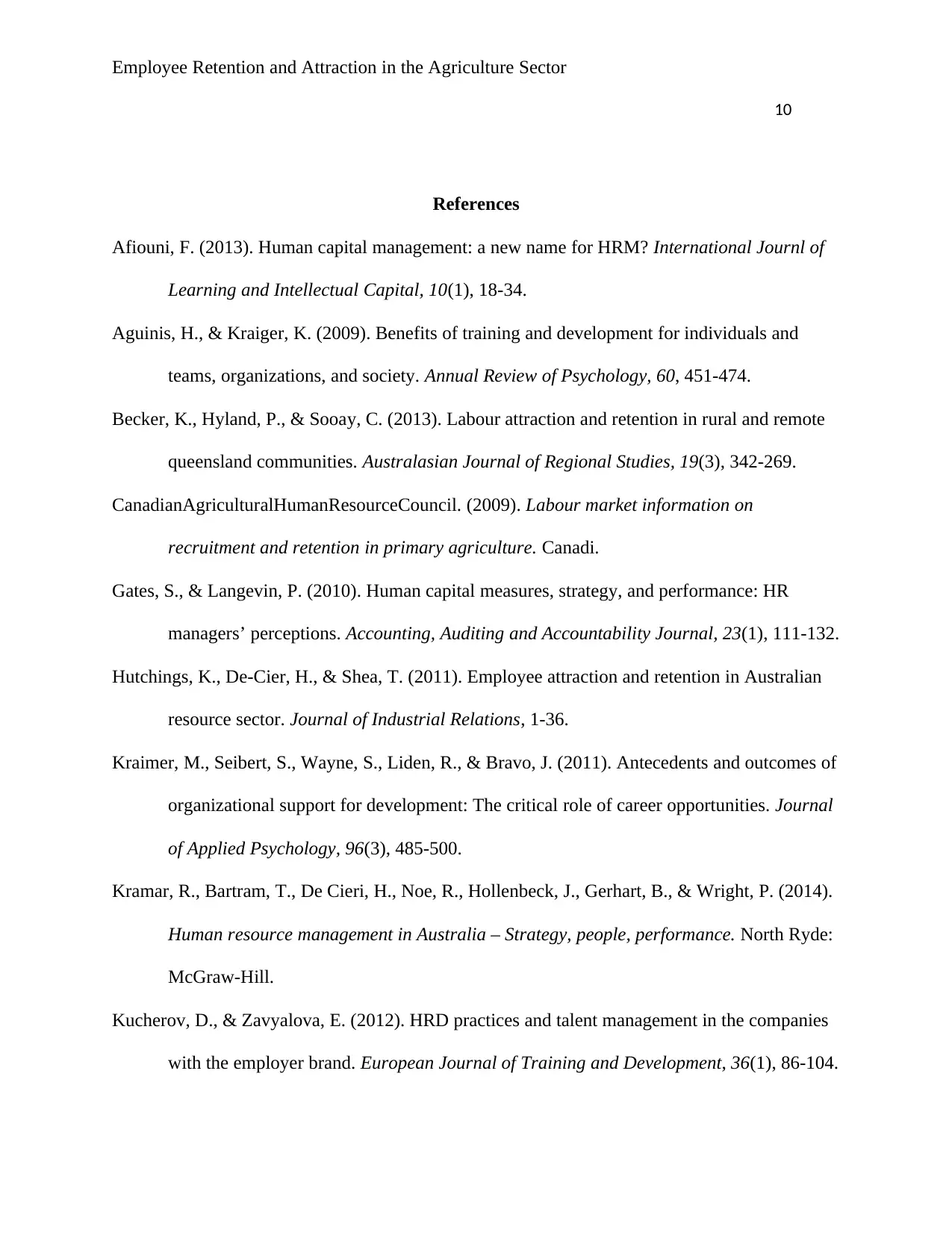
Employee Retention and Attraction in the Agriculture Sector
10
References
Afiouni, F. (2013). Human capital management: a new name for HRM? International Journl of
Learning and Intellectual Capital, 10(1), 18-34.
Aguinis, H., & Kraiger, K. (2009). Benefits of training and development for individuals and
teams, organizations, and society. Annual Review of Psychology, 60, 451-474.
Becker, K., Hyland, P., & Sooay, C. (2013). Labour attraction and retention in rural and remote
queensland communities. Australasian Journal of Regional Studies, 19(3), 342-269.
CanadianAgriculturalHumanResourceCouncil. (2009). Labour market information on
recruitment and retention in primary agriculture. Canadi.
Gates, S., & Langevin, P. (2010). Human capital measures, strategy, and performance: HR
managers’ perceptions. Accounting, Auditing and Accountability Journal, 23(1), 111-132.
Hutchings, K., De-Cier, H., & Shea, T. (2011). Employee attraction and retention in Australian
resource sector. Journal of Industrial Relations, 1-36.
Kraimer, M., Seibert, S., Wayne, S., Liden, R., & Bravo, J. (2011). Antecedents and outcomes of
organizational support for development: The critical role of career opportunities. Journal
of Applied Psychology, 96(3), 485-500.
Kramar, R., Bartram, T., De Cieri, H., Noe, R., Hollenbeck, J., Gerhart, B., & Wright, P. (2014).
Human resource management in Australia – Strategy, people, performance. North Ryde:
McGraw-Hill.
Kucherov, D., & Zavyalova, E. (2012). HRD practices and talent management in the companies
with the employer brand. European Journal of Training and Development, 36(1), 86-104.
10
References
Afiouni, F. (2013). Human capital management: a new name for HRM? International Journl of
Learning and Intellectual Capital, 10(1), 18-34.
Aguinis, H., & Kraiger, K. (2009). Benefits of training and development for individuals and
teams, organizations, and society. Annual Review of Psychology, 60, 451-474.
Becker, K., Hyland, P., & Sooay, C. (2013). Labour attraction and retention in rural and remote
queensland communities. Australasian Journal of Regional Studies, 19(3), 342-269.
CanadianAgriculturalHumanResourceCouncil. (2009). Labour market information on
recruitment and retention in primary agriculture. Canadi.
Gates, S., & Langevin, P. (2010). Human capital measures, strategy, and performance: HR
managers’ perceptions. Accounting, Auditing and Accountability Journal, 23(1), 111-132.
Hutchings, K., De-Cier, H., & Shea, T. (2011). Employee attraction and retention in Australian
resource sector. Journal of Industrial Relations, 1-36.
Kraimer, M., Seibert, S., Wayne, S., Liden, R., & Bravo, J. (2011). Antecedents and outcomes of
organizational support for development: The critical role of career opportunities. Journal
of Applied Psychology, 96(3), 485-500.
Kramar, R., Bartram, T., De Cieri, H., Noe, R., Hollenbeck, J., Gerhart, B., & Wright, P. (2014).
Human resource management in Australia – Strategy, people, performance. North Ryde:
McGraw-Hill.
Kucherov, D., & Zavyalova, E. (2012). HRD practices and talent management in the companies
with the employer brand. European Journal of Training and Development, 36(1), 86-104.
Paraphrase This Document
Need a fresh take? Get an instant paraphrase of this document with our AI Paraphraser
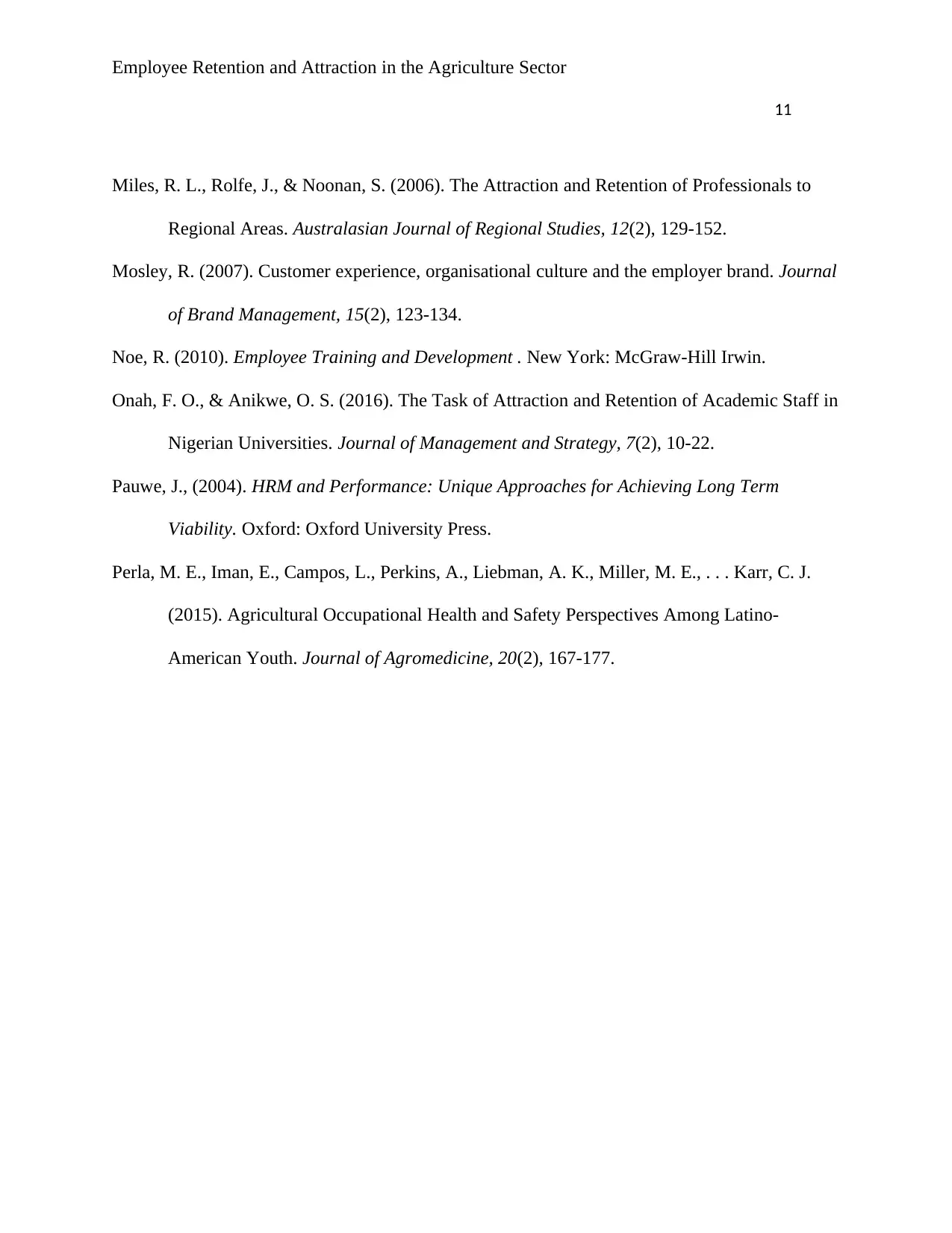
Employee Retention and Attraction in the Agriculture Sector
11
Miles, R. L., Rolfe, J., & Noonan, S. (2006). The Attraction and Retention of Professionals to
Regional Areas. Australasian Journal of Regional Studies, 12(2), 129-152.
Mosley, R. (2007). Customer experience, organisational culture and the employer brand. Journal
of Brand Management, 15(2), 123-134.
Noe, R. (2010). Employee Training and Development . New York: McGraw-Hill Irwin.
Onah, F. O., & Anikwe, O. S. (2016). The Task of Attraction and Retention of Academic Staff in
Nigerian Universities. Journal of Management and Strategy, 7(2), 10-22.
Pauwe, J., (2004). HRM and Performance: Unique Approaches for Achieving Long Term
Viability. Oxford: Oxford University Press.
Perla, M. E., Iman, E., Campos, L., Perkins, A., Liebman, A. K., Miller, M. E., . . . Karr, C. J.
(2015). Agricultural Occupational Health and Safety Perspectives Among Latino-
American Youth. Journal of Agromedicine, 20(2), 167-177.
11
Miles, R. L., Rolfe, J., & Noonan, S. (2006). The Attraction and Retention of Professionals to
Regional Areas. Australasian Journal of Regional Studies, 12(2), 129-152.
Mosley, R. (2007). Customer experience, organisational culture and the employer brand. Journal
of Brand Management, 15(2), 123-134.
Noe, R. (2010). Employee Training and Development . New York: McGraw-Hill Irwin.
Onah, F. O., & Anikwe, O. S. (2016). The Task of Attraction and Retention of Academic Staff in
Nigerian Universities. Journal of Management and Strategy, 7(2), 10-22.
Pauwe, J., (2004). HRM and Performance: Unique Approaches for Achieving Long Term
Viability. Oxford: Oxford University Press.
Perla, M. E., Iman, E., Campos, L., Perkins, A., Liebman, A. K., Miller, M. E., . . . Karr, C. J.
(2015). Agricultural Occupational Health and Safety Perspectives Among Latino-
American Youth. Journal of Agromedicine, 20(2), 167-177.
1 out of 11
Related Documents
Your All-in-One AI-Powered Toolkit for Academic Success.
+13062052269
info@desklib.com
Available 24*7 on WhatsApp / Email
![[object Object]](/_next/static/media/star-bottom.7253800d.svg)
Unlock your academic potential
Copyright © 2020–2025 A2Z Services. All Rights Reserved. Developed and managed by ZUCOL.





